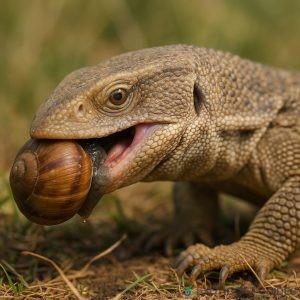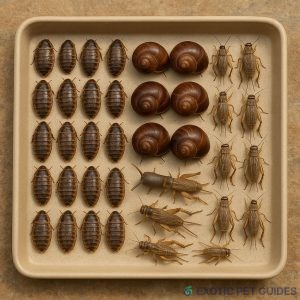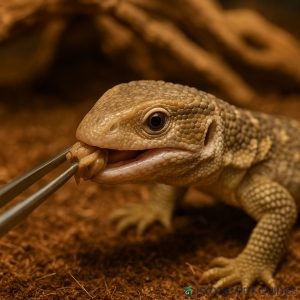Introduction
Feeding a Savannah Monitor (Varanus exanthematicus) is one of the most crucial aspects of its long-term health. These robust lizards are natural predators in the wild, and replicating their diet in captivity requires more than just tossing in crickets. In this guide, we’ll break down what to feed, how often, and the common dietary mistakes that lead to obesity and liver disease.
What Do Savannah Monitors Eat in the Wild?
In their native African habitats, Savannah Monitors feed primarily on invertebrates, especially snails, insects, and small arthropods. Occasionally, they may eat rodents or reptiles, but their digestion is not optimized for a heavy vertebrate-based diet.

Best Diet in Captivity
A healthy captive diet should include:
- Snails (with shell) – calcium-rich and natural
- Dubia roaches
- Crickets
- Superworms or mealworms (sparingly)
- Hard-boiled eggs or raw egg with shell (occasionally)
- Mice – only as an occasional treat, not a staple
Avoid: Pinky mice as a primary diet, too many fatty insects, or raw meats from the grocery store.

Feeding Schedule by Age
| Age Group | Frequency | Notes |
|---|---|---|
| Hatchlings (0–6 mo) | Daily | More protein, smaller portions |
| Juveniles (6–12 mo) | Every other day | Monitor growth, avoid overfeeding |
| Adults (1+ yr) | 2–3x per week | Focus on lean insect diet |

Supplements
- Calcium with D3: 2–3 times a week
- Multivitamins: Once a week
Dust insects lightly—don’t overdo it.
Common Feeding Mistakes
- Overfeeding rodents → Leads to fatty liver disease
- Underfeeding variety → Nutritional imbalances
- Ignoring UVB needs → Poor calcium absorption despite supplement use
Final Tips
Feeding time is also bonding time. Use tongs to feed, and observe for signs of aggression or disinterest. Adjust diet seasonally and monitor body condition closely—Savannah Monitors are prone to obesity in captivity.